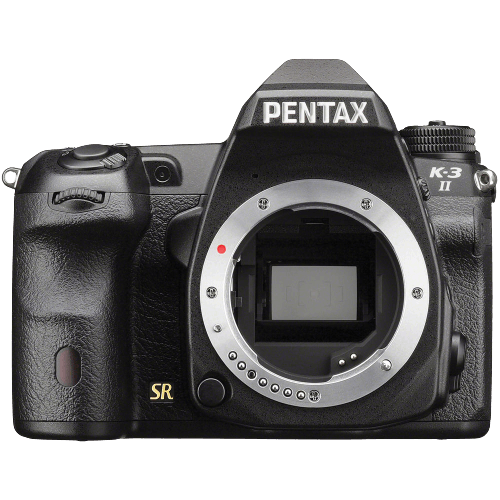Pentax K-3 II Specs and Scores

The Pentax K-3 II scores a 69/100 on our scale. Announced on April 23, 2015, this DSLR camera was released with a launch price of $1100. Measuring 131 x 100 x 77mm and weighing 800g (1.76lbs), it offers a compact and lightweight option for photographers.
Despite being a 2015 model, the K-3 II still holds its ground in today’s market. Its specifications cater to a variety of photography needs, making it a reliable choice for enthusiasts and professionals alike.
Pentax K-3 II Overview and Optics
The Pentax K-3 II receives a score of 74/100 for its optics. This camera features 24.35 megapixels, an 8.3 shooting speed, and a CMOS sensor. The processor is the Prime III, and the DXOMARK score for the sensor is 80. The sensor size is APS-C, and the lens mount is the Pentax KAF. Image stabilization is present, and the aspect ratio is 3:2.
These specifications show that the Pentax K-3 II has a strong performance in the market. The 24.35 megapixels offer high-resolution images, while the 8.3 shooting speed provides fast capture. The CMOS sensor and Prime III processor ensure quality image processing. The APS-C sensor size and Pentax KAF lens mount offer versatility and compatibility with various lenses. Image stabilization and a 3:2 aspect ratio contribute to the camera’s overall performance.
Considering these specifications, the Pentax K-3 II is a reliable camera with competitive optics. Its features meet the demands of today’s market, making it a suitable choice for photographers seeking quality and versatility.
Pentax K-3 II Video Performance
The Pentax K-3 II receives a video score of 70 out of 100. The camera offers Full HD video resolution with maximum dimensions of 1920 x 1080, providing crisp and clear visuals. With a maximum video frame rate of 60fps, the K-3 II captures smooth footage, crucial for fast-paced action shots.
In comparison to today’s market, the Pentax K-3 II’s video capabilities are decent, but not outstanding. Many contemporary cameras offer 4K video resolution, which surpasses Full HD. However, the K-3 II does include a time-lapse functionality built in, adding versatility to its video features.
The Pentax K-3 II’s video capabilities are satisfactory for most users, but professionals and enthusiasts seeking cutting-edge video quality may opt for cameras with higher resolution and advanced features.
Pentax K-3 II Features and Benefits
The Pentax K-3 II receives a feature score of 59/100, which offers a decent range of specifications. With a screen size of 3.2 inches and a resolution of 1,037,000 dots, the display provides clear image previews and menu navigation. However, it lacks a touchscreen and flip screen, which limits its ease of use and versatility in certain shooting situations.
The camera includes GPS, a valuable feature for photographers who want to geotag their images. Unfortunately, the Pentax K-3 II does not support WIFI or Bluetooth connectivity, making it less convenient for sharing and transferring images compared to other modern cameras.
Considering these features, the Pentax K-3 II stands as a solid choice for photographers who prioritize GPS functionality and image quality over advanced connectivity options and display features.
Pentax K-3 II Storage and Battery
The storage and battery of the Pentax K-3 II receive a score of 65 out of 100. This camera has two memory card slots, which accept SD, SDHC, and SDXC cards. This feature allows for ample storage and flexibility when capturing images. However, the camera’s battery life is relatively short, offering only 720 shots per charge. The battery used is a D-LI90 type, which does not support USB charging.
In the current market, the Pentax K-3 II’s storage options are competitive, but its battery life falls short compared to other cameras. The lack of USB charging is a disadvantage that may affect the user’s experience. Despite these shortcomings, the camera still offers solid performance in other areas.
